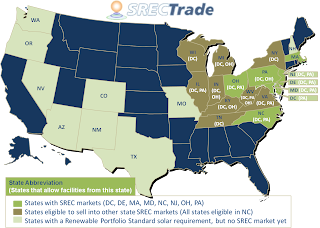It probably wouldn't be too surprising to learn that I really like solar technology. Passive solar design, solar air heating, solar cooling, daylighting a space, solar water heating, and PV are all fascinating to me. I even count biofuels as "solar" too as we're using sunlight to grow plants specifically designed for liquid, transportable fuel. The energy transition that we're in now feels to me how I think people in the 50's were thinking about space exploration. Those were hopeful times where technology was magical to the common man and promised positive changes in the future. Solar today is very much like that; almost everyone sees the promise of it even if they have reservations about its practicality. My argument though is that solar is also, in all its forms, truly the only sound energy option for the next 25 years or more. I don't claim that solar will be the only energy technology we'll use, but I see it as the heavy lifter in our energy mix and in that it will provide the bulk of the power we'll need to live the lives we want to live.
I don't say this as an idealist or insider looking to help solar win out over other technologies. I say it because there are no other candidates on the horizon that will be as scalable and affordable as distributed solar is now and will continue to be for some time. That is why I'm in the solar business. I like a clean environment but that didn't motivated me to change careers. I saw an opportunity to get into a growing solar industry on the ground floor; I see our society as a whole as getting in on the
ground floor of solar right now too. My job is to grow solar water heating in the residential space. I work to find projects and partners across my region and each system sold is hard fought. I know that we're not far from a time when solar technology will be on every building, however because we're already seeing the
military move in this direction today. By 2013, solar won't be a novelty anymore but a fundamental building component.
 |
| Europe is already there in many areas; what happens when the sleeping giant (US) awakes? |
If solar is inevitable, then why even write this post? Because the journey is just as important as the destination. Growing a solar base of energy capacity has been sporadic up to this point because we haven't really acknowledged the fundamental instability of our existing energy portfolio. We're really the only major country without a comprehensive energy policy which is even more damaging because we have the largest impact on world affairs. Without a consensus behind solar technologies, we'll continue to be distracted by the loser technologies. We'll fritter away our time & money on dead ends which will make the inevitable shift to solar that much more difficult.
The Losers
Nuclear won't win because we've had over 60 years to figure out a way to handle the waste, danger, and cost of a
nuclear plant for electricity generation; we haven't yet and probably won't for at least another 30 years or more. Coal is plentiful and will probably have a role for some time, but the world will no longer accept externalizing the environmental or societal costs of coal production for much longer. Agree or disagree, but climate change is an issue that is not going to go away. Natural gas is plentiful today and at cheap prices but as we continue to load shift transportation and electricity to this fuel, its run as a fossil fuel darling will end too. If people like
T. Boone Pickens can make their case, we'll be burning a lot more natural gas in the coming years; rising prices are sure to follow that move.
I want to be positive towards solar without resorting to throwing other energy sources under the bus (maybe I shouldn't have titled this section The Losers then ;-). Selling against something is confrontational and tends to put people on the defensive if their world view is being challenged. Enough can be found on the web bashing fossil fuels, but I wanted to point out up front that the discovery of oil in particular has been one of the most transformative developments in all of human history. There may have never been a better time to be a human being than right now, and we owe this fact to oil. It's inevitable that solar technologies will displace oil though and not because oil is dirty or inefficient or imported from hostile countries. It won't even really be much of a choice to use less oil; it is because oil is becoming too expensive to burn anymore.
 |
| 2008 numbers; the line is pointing up again today in 2011 |
Drill baby drill
We're already at a trading range
between $90 and $115 per barrel with a
global population at or near 7 billion people and the following 3 facts can only lead to even higher prices:
- We're going add another billion people in the next 15 years (more mouths to feed).
- A greater percentage of the world will demand to live with a standard of living as we have in the US (more cars to drive).
- We are consuming oil as we extract it today and no major reserves exist to make up for rising demand (nothing lasts forever).
Sure we have market players trying to
manipulate oil prices. Sure we limit where we drill new wells based on
aesthetic and
environmental factors. The rarely discussed fact is that we haven't found any easily extractable oil reserves in any sort of quantity since the North Sea and now that's almost gone. We need to be finding reserves on the scale of Saudi Arabia's
Ghawar field every couple of years to keep up with the forecasted demand growth from rising global populations but we aren't. We drill everyday (baby) but we have to acknowledge that the wells are literally running low. The excellent but sobering documentary
The End of Suburbia makes the case for what all this means much better than I can. My contribution to the debate is to point out that the solar technology we have today can mitigate most if not all these troubles in a very, very short period of time.
Why solar wins
Once we see the scope of the challenge we face, the only conceivable step to take will be a large scale roll out of distributed solar technologies (PV, water heating, space heating, passive design, and daylighting). It will be the most logical step because it is the step that individuals can actually participate in. Plumbers can plumb solar water heaters with little or no training. Carpenters can install skylights today. Homeowners can connect more PV panels to their homes as their budget allows over time. New buildings will capture and shed solar heat with no need for new technology--just a rearrangement of building and landscaping materials we use already. We won't have to wait for anyone in charge or anything else to be invented for a dramatic roll out to occur. It is really up to us individuals.
 |
| Roofing crew installing a solar water heating system |
I can imagine that this post will have critics; I haven't really tried to make a convincing argument for many of the details I brought up. I just wanted to lay out the way I see things though, and I get the feeling that many others are of a similar mind. Change in life is inevitable and oftentimes difficult. The sooner that you recognize the change, the better you can prepare, and the smoother the transition will be. I'll continue to sell solar systems everyday because I enjoy the product, the challenge and the people in the industry. I know that solar won't be novel for long though and that in many ways, I'm working my self out of a job. I think that I'll be able to handle that change just fine when the time comes though.



























